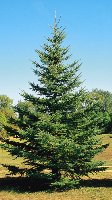Mon-Fri 9am - 5pm Mountain time
Black Hills Spruce vs Empress Tree
Picea glauca var. densata
Paulownia tomentosa
Black Hills Spruce is a subspecies of White Spruce native to the Black Hills of South Dakota. It has a strongly conical form, slower growth rate and denser foliage than typical white spruce, making it preferable as a specimen tree for smaller suburban lawns. It also responds well to pruning, and can be used as a hedge or even bonsai.
The Empress Tree is a fast growing, ornamental shade tree. It has purple, fragrant flowers that are quite attractive. The flowers emerge before the leaves in early spring. The leaves of this tree can grow very large, up to 30 cm long.
As one of the fastest growing trees in the world, this tree has been given considerable attention for carbon sequestration projects. It drops many seeds which can make it invasive in warmer climates. Please do some research and plant the right tree in the right place.
The Empress tree’s genus name comes from Princess Paulowna, daughter of Tsar Paul I of Russia.
Black Hills Spruce Quick Facts
Empress Tree Quick Facts
In row spacing: 3 - 4 m (10 - 12 ft)

